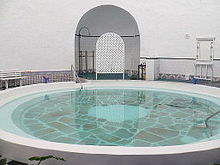Blogs
History Spa
Spa therapies have existed since the classical times when taking bath with water was considered as a popular means to treat illnesses. The practice of traveling to hot or cold springs in hopes of effecting a cure of some ailment dates back to prehistoric times. Archaeological investigations near hot springs in France and Czech Republic revealed Bronze Age weapons and offerings. In Great Britain, ancient legend credited early Celtic kings with the discovery of the hot springs in Bath, England.
Many people around the world believed that bathing in a particular spring, well, or river resulted in physical and spiritual purification. Forms of ritual purification existed among the Native Americans, Babylonians, Egyptians, Greeks, and Romans. Today, ritual purification through water can be found in the religious ceremonies of Jews, Muslims, Christians, Buddhists, and Hindus. These ceremonies reflect the ancient belief in the healing and purifying properties of water. Complex bathing rituals were also practiced in ancient Egypt, in prehistoric cities of the Indus Valley, and in Aegean civilizations. Most often these ancient people did little building construction around the water, and what they did construct was very temporary in nature.
Bathing in Greek and Roman times
Coriovallum Roman baths in Heerlen, The Netherlands (reconstructed)
Some of the earliest descriptions of western bathing practices came from Greece. The Greeks began bathing regimens that formed the foundation for modern spa procedures. These Aegean people utilized small bathtubs, wash basins, and foot baths for personal cleanliness. The earliest such findings are the baths in the palace complex at Knossos, Crete, and the luxurious alabaster bathtubs excavated in Akrotiri, Santorini; both date from the mid-2nd millennium BC. They established public baths and showers within their gymnasium complexes for relaxation and personal hygiene. Greek mythology specified that certain natural springs or tidal pools were blessed by the gods to cure disease. Around these sacred pools, Greeks established bathing facilities for those desiring healing. Supplicants left offerings to the gods for healing at these sites and bathed themselves in hopes of a cure. The Spartans developed a primitive vapor bath. At Serangeum, an early Greek balneum (bathhouse, loosely translated), bathing chambers were cut into the hillside from which the hot springs issued. A series of niches cut into the rock above the chambers held bathers’ clothing. One of the bathing chambers had a decorative mosaic floor depicting a driver and chariot pulled by four horses, a woman followed by two dogs, and a dolphin below. Thus, the early Greeks used the natural features, but expanded them and added their own amenities, such as decorations and shelves. During later Greek civilization, bathhouses were often built in conjunction with athletic fields.
The Romans emulated many of the Greek bathing practices. Romans surpassed the Greeks in the size and complexity of their baths. This came about by many factors: the larger size and population of Roman cities, the availability of running water following the building of aqueducts, and the invention of cement, which made building large edifices easier, safer, and cheaper. As in Greece, the Roman bath became a focal center for social and recreational activity. As the Roman Empire expanded, the idea of the public bath spread to all parts of the Mediterranean and into regions of Europe and North Africa. With the construction of the aqueducts, the Romans had enough water not only for domestic, agricultural, and industrial uses, but also for their leisurely pursuits. The aqueducts provided water that was later heated for use in the baths. Today, the extent of the Roman bath is revealed at ruins and in archaeological excavations in Europe, Africa, and the Middle East.
The Romans also developed baths in their colonies, taking advantage of the natural hot springs occurring in Europe to construct baths at Aix and Vichy in France, Bath and Buxton in England, Aachen and Wiesbaden in Germany, Baden, Austria, and Aquincum in Hungary, among other locations. These baths became centers for recreational and social activities in Roman communities. Libraries, lecture halls, gymnasiums, and formal gardens became part of some bath complexes. In addition, the Romans used the hot thermal waters to relieve their suffering from rheumatism, arthritis, and overindulgence in food and drink. The decline of the Roman Empire in the west, beginning in AD 337 after the death of Emperor Constantine, resulted in Roman legions abandoning their outlying provinces and leaving the baths to be taken over by the local population or destroyed.
Thus, the Romans elevated bathing to a fine art, and their bathhouses physically reflected these advancements. The Roman bath, for instance, included a far more complex ritual than a simple immersion or sweating procedure. The various parts of the bathing ritual — undressing, bathing, sweating, receiving a massage, and resting — required separated rooms which the Romans built to accommodate those functions. The segregation of the sexes and the additions of diversions not directly related to bathing also had direct impacts on the shape and form of bathhouses. The elaborate Roman bathing ritual and its resultant architecture served as precedents for later European and American bathing facilities. Formal garden spaces and opulent architectural arrangement equal to those of the Romans reappeared in Europe by the end of the 18th century. Major American spas followed suit a century later.



